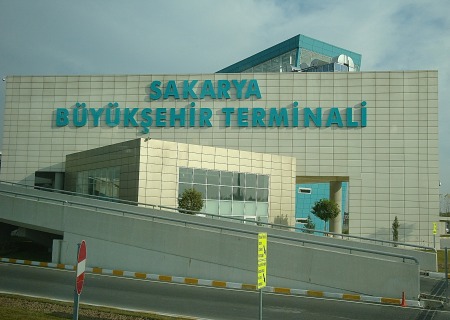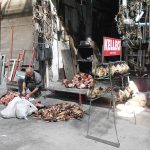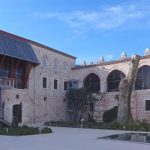Imagine a bus station.
It’s right in the centre of town. On the top floor buses arrive and depart for distant destinations. On the bottom floor buses wait to whisk passengers to nearby localities. Big boards indicate which bus leaves from which stand. Spare space is filled with cafes, shops and flowerbeds. Across the road stand hotels where travellers arriving late at night can find a bed without having to travel far while those leaving early have time to grab breakfast before they need to depart. Bus times and ticket prices can be picked up without having to make a special journey. Why, even the train station is just across the road. People come and go whether or not they’re actually catching a bus.
This is public transport at its most user-friendly, public transport as designed for its customers. This is Denizli’s fine new bus station, sensibly rebuilt in 2014 on the same site as the old one.
Now imagine another bus station.
Not only is it not in the town centre but it’s so far out of the town itself that you could easily imagine that you’ve somehow managed to miss it. Arriving, there are no servises (transfer) buses to run passengers back to the centre through which they’ve just passed without being allowed to disembark. The hotels are all in the centre – opposite the old bus station, in fact. The very thought of coming back here to check bus times and prices is depressing. Needless to say there is absolutely nobody here who does not have to be, and the atmosphere is one of barely-stifled irritation.
This is public transport at its least user-friendly, public transport as designed by a committee of town planners and property developers none of whom ever sets foot on a bus. This is Aydın’s new bus station, rebuilt so far out of town in 2014 that it’s almost laughable to call it Aydın bus station.
Sadly Turkey has many more new bus stations like Aydın’s than there are like Denizli’s.
There is Nevşehir bus station, for example, built so far outside Nevşehir that to take a taxi into town would exceed the cost of the intercity bus ticket that brought most passengers to it. Even to walk from the sign on the road to the bus stands would exhaust anyone with heavy luggage.
Then there is the Seferihisar one, built in a location that forces visitors to take not one but two additional buses to reach the nearby seaside resort of Sığacık in spite of the town’s claim to Slow City sustainable status.
Then there is Safranbolu bus station that forces its largely tourist clientele to catch two more buses to get to the hotels of the Çarşi area.
It’s much harder to think of new bus stations like Denizli’s although there are a few old bus stations such as the one in Bodrum that are still just about managing to cling to their city-centre locations. In a rare piece of good news plans to move the central Göreme bus station were recently shelved. In Selçuk buses continue to use the old town-centre bus station while the shell of the new one stands overgrown and forgotten in its distant location.
 To be fair, some of the new bus stations are almost works of art. The one at Sakarya, for example, looks as if could have been a Frank Gehry cast-off while the one in Afyon enables passengers to watch kaymaklı lokum (Turkish delight with cream) being made while they wait. Just a shame that it’s way out of town on one side while the local bus terminal is way out of town on another.
To be fair, some of the new bus stations are almost works of art. The one at Sakarya, for example, looks as if could have been a Frank Gehry cast-off while the one in Afyon enables passengers to watch kaymaklı lokum (Turkish delight with cream) being made while they wait. Just a shame that it’s way out of town on one side while the local bus terminal is way out of town on another.
Believe it or not, there was a time, not so very long ago, when all Turkey’s bus station were like Denizli’s. One of the great joys of travelling here was that you knew that you were following in the path of all the thousands who’d gone before you and for whom the system had grown up organically. Buses left from where you wanted them to and dropped you back where you wanted to be dropped. Rarely did a bus whisk past someone’s house with cries of “yasak (forbidden)!” from the conductor when they asked to be allowed to get off. Those services were designed for the convenience of their customers rather than for those who saw only the value of the prime city-centre land the terminals were occupying.
Then something changed. The rot started to set in quite a long time ago, probably with Bursa bus station which was always so far from the town centre that it could take as long to get from the terminal to a hotel as it had taken to get from Istanbul to Yalova. There, too, the municipality would have no truck with providing free servis buses to help passengers complete their journey.
Nor is this just a gripe about saving money.
Servis buses have space for luggage and speed passengers to the end of their journey. Normal buses, in contrast, are not designed to be used by people with heavy luggage which must often be hauled up steps and into the general chaos. Servis buses don’t need tickets. Normal buses require even non-locals in transit to get to grips instantly with the latest new-fangled card ticketing system. Normal buses also stop everywhere along their route, thus dragging out the last leg of the journey interminably.
The saddest thing of all about the steady splintering of what had been Turkey’s almost perfect integrated public transport system is that in an age of global warming it’s vital that more people are persuaded to get out of their cars and onto the bus. The only way that is ever going to happen, though, is if journeys are made as quick and easy for passengers as possible.
And the way to ensure that is certainly not to build new bus terminals in the middle of nowhere.

Written: 9 February 2015


